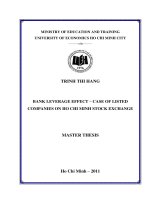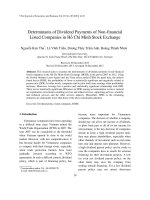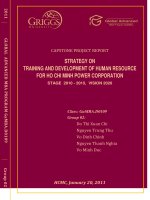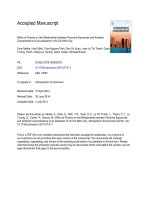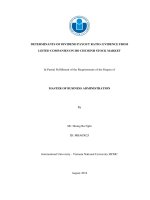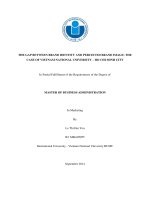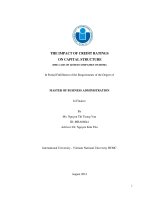Bank leverage effect case of listed companies on ho chi minh stock exchange
Bạn đang xem bản rút gọn của tài liệu. Xem và tải ngay bản đầy đủ của tài liệu tại đây (2.15 MB, 115 trang )
MINISTRY OF EDUCATION AND TRAINING
UNIVERSITY OF ECONOMICS HO CHI MINH CITY
----------o0o---------
TRINH THI HANG
BANK LEVERAGE EFFECT – CASE OF LISTED
COMPANIES ON HO CHI MINH STOCK EXCHANGE
MASTER THESIS
Ho Chi Minh – 2011
MINISTRY OF EDUCATION AND TRAINING
UNIVERSITY OF ECONOMICS HO CHI MINH CITY
----------o0o---------
TRINH THI HANG
BANK LEVERAGE EFFECT – CASE OF LISTED
COMPANIES ON HO CHI MINH STOCK EXCHANGE
MAJOR: BANKING AND FINANCE
MAJOR CODE: 60.31.12
MASTER THESIS
INSTRUCTOR: PROFESSOR BUI KIM YEN
Ho Chi Minh – 2011
ACKNOWLEDGEMENT
First and foremost I would like to thank my supervisor, Professor Bui Kim
Yen for her guidance and support.
Special thanks also go to all of my lecturers at Banking and Finance Faculty,
University of Economics Ho Chi Minh City for their teaching and guidance during
my Master of Banking and Finance course.
I also wish to thank all my coworkers in Military Bank, my friends in Bank
for Investment and Development of Viet Nam, Au Viet Securities for their great
support during my master thesis writing.
Finally, my greatest thanks would go to my family including my parents, my
sisters and my brothers who are the greatest encouragement for me to overcome all
difficulties in my life.
i
ABSTRACT
The thesis aims to add empirical evidence to the corporate finance literature
by looking at firms’ debt choice and performance. This thesis also find the
relationship between firms’ debt choice and bank loans in companies listed on Ho
Chi Minh Stock Exchange (HOSE) of Vietnam as an emerging market.
The thesis consists of five chapters. After an introductory chapter, the study
reviews the existing literature on the capital structure controversy with an emphasis
on the recent empirical works. The following third chapter provides the research
methodology for the study. The study applies panel data procedures, least square
regression to test surrounding issues of capital structure of 92 firms listed on HOSE
for the period 2007 and 2010. While the main findings of this study which are
consistent with theories are reported in the fourth chapter, there are new major
insights that represent the special case of emerging markets in general and Vietnam
in particular. These main insights, as well as the main conclusions of the study, are
summarized in Chapter 5, including some limitations and recommendations for
future researches.
Our findings are that many of the factors that are found to be significant in
the determination of capital structure and performance of the firms listed on HOSE
are the same as those found in developed and developing capital markets such as
firm size, asset turnover. Besides, we find that the listed firms’ debt choice affect
performance negatively.
In addition to the State Bank of Vietnam‘s general lending principals such as
legal establishment of firm, legal purpose of loan, earning capacity of the business
and profitable project, our findings suggest that banks should take more
considerations on firms’ asset tangibility, size and asset turnover when making
decisions on loans to corporate.
Keywords: Capital structure, firm performance, bank loan, Vietnam, HOSE.
ii
CONTENTS
Acknowledgement ..................................................................................................... i
Abstract .................................................................................................................... ii
Contents ................................................................................................................... iii
List of Figures .......................................................................................................... v
List of Tables........................................................................................................... vi
Abbreviations ........................................................................................................ vii
CHAPTER 1: INTRODUCTION
1.1 Research Background......................................................................................... 1
1.2 The usefulness of the research ........................................................................... 2
1.3 Research objectives ............................................................................................ 2
1.4 Scope and methodology ..................................................................................... 3
1.5 The structure of the study................................................................................... 3
CHAPTER 2: LITERATURE REVIEW
2.1 Introduction ........................................................................................................ 5
2.2 Capital structure theory and firm performance .................................................. 5
2.3 Maturity structure and bank loan theory .......................................................... 12
2.4 Conclusion........................................................................................................ 20
CHAPTER 3: RESEARCH METHODOLOGY
3.1 Introduction ...................................................................................................... 21
3.2 Data specifications ........................................................................................... 21
3.2.1 Research sample description ......................................................................... 21
3.2.2 Variable Explanation ..................................................................................... 22
3.2.2.1 Financial leverage ................................................................................... 22
3.2.2.2 Return on equity ...................................................................................... 23
3.2.2.3 Return on assets ....................................................................................... 23
3.2.2.4 Asset tangibility....................................................................................... 24
3.2.2.5 Asset turnover ......................................................................................... 24
iii
3.2.2.6 Firm Size ................................................................................................. 25
3.2.2.7 Firm age................................................................................................... 25
3.2.2.8 Growth opportunities............................................................................... 26
3.2.2.9 Industrial sector ....................................................................................... 26
3.3 Hypothesis and empirical model specification ................................................ 27
3.3.1 Model 1: Firm Leverage Model .................................................................... 27
3.3.2 Model 2: Firm Performance Model .............................................................. 28
3.3.3 Model 3: Bank Loan Model .......................................................................... 30
CHAPTER 4: DATA ANALYSIS AND FINDINGS
4.1 Introduction ...................................................................................................... 32
4.2 Descriptive Statistics ........................................................................................ 32
4.3 Results of Leverage Model .............................................................................. 34
4.4 Results of Firm Performance Model ................................................................ 37
4.5 Results of Bank Loan Model............................................................................ 43
CHAPTER 5: CONCLUSION
5.1 Introduction ...................................................................................................... 48
5.2 Conclusion........................................................................................................ 48
5.3 The implications of the research ...................................................................... 49
5.4 Limitations and recommendations for future research .................................... 50
References .............................................................................................................. 52
Appendix A – Regression results of models .......................................................... 59
Appendix B – Industry classification ..................................................................... 72
Appendix C – Financial ratios of 92 firms listed on HOSE from 2007 to 2010.... 75
Appendix D – Creations of variables for the models ............................................. 91
iv
LIST OF FIGURES
Figure 1.1: Research methodology ......................................................................... 3
Figure 3.1: Outline of chapter 3 ............................................................................ 21
Figure 3.2: Summary of research data collection ................................................. 22
v
LIST OF TABLES
Table 4.1: Number of companies per industry ....................................................... 32
Table 4.2: Descriptive statistic for the variables used in the study ........................ 33
Table 4.3: The correlations between ROA and others variables ........................... 33
Table 4.4: The correlations between ROE and others variables ............................ 34
Table 4.5: The reported results of Leverage Model ............................................... 34
Table 4.6: The final reported results of Leverage Model ...................................... 37
Table 4.7: The reported results of Firm Performance Model (by using ROA)...... 38
Table 4.8: The reported results of Firm Performance Model (by using ROE) ...... 42
Table 4.9: The final reported results of Firm Performance Model (by using
ROA) with significant variables............................................................................. 42
Table 4.10: The final reported results of Firm Performance Model (by using
ROE) with significant variables ............................................................................. 43
Table 4.11: The reported results for TOBIT´s estimations of Bank Loan Model . 44
Table 4.12: The final reported results of TOBIT´s estimations of Bank Loan
Model ..................................................................................................................... 47
vi
ABBREVIATIONS
BAS
Basic Material
CONS
Construction and material
CUS
Customer good and services
GLS
Generalized least square regression
GROWTH
Growth opportunities
HNX
Ha Noi Stock Exchange
HOSE
Ho Chi Minh Stock Exchange
INDU
Industrial sector
IT
Information Technology
LEV
Financial leverage
OIL
Oil and gas
ROA
Return on assets
ROE
Return on equity
SIZE
Firm size
TANG
Asset tangibility
TRAN
Transportation
TURN
Asset turnover
UTI
Utilities
VND
Vietnam Dong
vii
CHAPTER 1: INTRODUCTION
1.1 RESEARCH BACKGROUND
The capital structure theory has been one of the most important background
literatures when studying the corporate finance. This theory was originated in 1958
by Modigliani and Miller who gave a rigorous proof of the independence of a firm’s
values and its capital structure mix. The capital structure of a firm explains the ways
in which a firm finances its investment and overall operations. It consists mainly of
a combination of debt and equity as well as all other sources of finance available to
the firm. It has been obvious from various studies that one factor which has affected
and will continue to affect a firm’s financial performance is the choice of its capital
structure mix. There have been many studies conducted to find out the optimal
capital structure for corporate from this background but no formula or theory that
decisively provides optimal capital structure for a firm has been found yet.
There are many factors affecting the choice of firm’s capital structure. These
factors may vary substantially from company to company, from industry to industry
and from country to country. While the studies on the determinants on the capital
structure and the effects of capital structure on firm performance have been very
popularly conducted in almost every developed country in the world, these kinds of
research have still been limited in Viet Nam. Meanwhile the way an organization is
financed is of paramount importance to both the managers of firms and providers of
funds. This is because if a wrong mix of finance is employed, the performance and
survival of the enterprise may be seriously affected. This is the motivation for me to
do this study with the hope to have deeper understanding about the role of capital
structure on firm’s performance. Besides, we also do a research on the conditions
and determinants firms must have when accessing funds from banks. These
examinations are conducted in Viet Nam as a developing country.
1
The rest of this chapter provides the overview of the usefulness of the
research, the research objectives, research methodology and the structure of the
research.
1.2 THE USEFULNESS OF THE RESEARCH
Firstly, this study helps firm managers to identify and implement the optimal
capital structure best for their firms, applicable to their industry and minimize the
cost of financing while maximizing the firm’s overall value and financial
performance.
Secondly, the study is a contribution to the debate on what determinants
affecting the choice of capital structure of Viet Nam firms in general and firm listed
on HOSE, in particular. Our findings are the same as those found in developed
countries’ researches that firm size, asset turnover affect the choice of firm’s capital
structure. The findings do not support the effects of industry factors on the capital
structure choice and firm performance.
Finally, this study helps banks to make right decisions when making
decisions on loans to enterprises in the manners to limit the risks incurring from
loans. Especially, this study gives empirical evidence regarding to the use of bank
loan for the period of 2007 and 2010 of firms listed on HOSE of Viet Nam. From
this finding, banks will have suitable strategies in choosing the best firms and the
best industry to finance in.
1.3 RESEARCH OBJECTIVES
This study is conducted to answer the four following questions:
-
What are the determinants affecting the leverage of firms listed on HOSE?
-
What are the relationships between the leverage and firm performance of
firms listed on HOSE?
-
What are the relationships between industrial sectors, firms leverage and
firms performance?
2
-
What are the determinants banks take more concern when issuing loans to
firms listed on HOSE in general and in Viet Nam situation in particular?
1.4 SCOPE AND METHODOLOGY
My study uses the data collected from the audited financial statements of 92
firms listed on Ho Chi Minh Stock Exchange for the period from 2007 and 2010.
These companies are classified into 8 main industrial sectors in the economy.
I have the Eview software version 4 to test all my data. The main tools used
are Descriptive statistic, Model regression, etc., to obtain the results for financial
models.
Figure 1.1: Research Methodology
Literature reveiw
Hypothesis and empirical models
Data collection
Estimation and testing
Are results consistent with theory?
Conclusions and recommendations
1.5 THE STRUCTURE OF STUDY
The structure of the study consists of 5 chapters:
Chapter 1: Introduction.
3
This chapter introduces the general knowledge about the study. They are
research background, research usefulness, research objectives, the scope and the
methodology of the study.
Chapter 2: Literature Review
The purpose of literature review is to present the theories conducted by
economists in the past. From these theories, we mention to the points used for the
studying of this paper.
Chapter 3: Methodology
This chapter shows the way we conduct my thesis. It is a quantitative
research to test the suitable of popular financial models in the world to Viet Nam.
The data used for this model are collected directly from the audited financial
statements of listed firms on Ho Chi Minh Stock Exchange in Viet Nam.
Chapter 4: Data analysis and findings
The purpose of this chapter is to give the results after processing the data. In
other words, the results of financial models mentioned in chapter 3 are shown.
Chapter 5: Conclusions, Recommendations and Limitations
This chapter will conclude the whole content of the study. It also gives out
the limitations of the study and raise up some problems for further studies.
4
CHAPTER 2: LITERATURE REVIEW
2.1
INTRODUCTION
The purpose of this chapter is to review the theories related to capital
structure, firm performance and bank loan. Besides, the empirical studies of various
researchers in many countries have also been mentioned in order to show an overall
picture related to capital structure issue.
2.2
CAPITAL STRUCTURE THEORY AND FIRM PERFORMANCE
Modern capital structure theory consists of two independent variables: debt
and equity financing. Modigliani and Miller (1958) propose in their article that a
change in the firm’s capital structure has no long – term effect on its market value
and firm’s value is completely independent on its combination of debt and equity.
The theory is developed in the context that the capital market is perfect (there is no
tax, bankruptcy and transaction cost), the corporate can borrow at the same interest
rate as individual do and all investors have the same information.
Many criticisms have been appeared due to these unrealistic assumptions.
First of all, the assumption that corporate and personal leverage can become a
perfect substitute was a mirage and unrealistic. In a real world situation, corporate
borrow at a lower rate than individuals (Durant, 1959). Secondly, in their
assumptions Modigliani and Miller exclude transaction cost such as brokerage cost,
etc. that both corporate and individual would have to bear in real world situation
(Ghosh, 2008). Thus in 1963, they introduce corporate tax and transaction cost and
conclude that leverage would increase firm’s value because of tax deductible from
interest payment on loans while dividend income from shares has not.
In the field of capital structure, there have various propositions and model
been argued by different studies on why firms make use of debt financing. The most
prominent of such theories or models have been trade-off-theory, agency cost
model, optimal capital structure theory and the pecking order theory.
5
The trade-off models have dominated the capital structure literature. The
pioneers of this theory are Modigliani and Miller (1963). DeAngelo and Masulis
(1980) predict that firms will seek to maintain an optimal capital structure by
balancing the benefits and the costs of debt. The benefits include the tax shield
whereas the costs include expected financial distress costs. The implication of these
trade-off models is that firms have target leverage and they adjust their leverage
toward the target over time.
The agency theory focused on determining the most efficient contract
governing the principal-agent relationship. There are two kinds of conflict: the
conflict between the owners of the firm and the managers and the conflict between
the owners of the firm and the debt holders. The conflict becomes obvious when
there is a risk of default. This may create underinvestment or “debt overhang”
problem (Myers 1977). In such a scenario, debt would have a significant negative
effect on a corporate financial performance. The implication of the agency cost
theory is to determine an optimal capital structure by minimizing the costs arising
from conflicts between the parties involved.
Pecking order theory proposed by Myers that firms prefer to finance new
investment, first internally with retained earnings, then with debt, and finally with
an issue of new equity. The implication of the pecking order theory and the optimal
capital structure theory is that the profitable firm will have low debt-to-equity ratio
and will only borrow or issue debt securities when its investment requirement
exceed its internal source of financing such as cash flow and retained earnings.
There is not only the capital structure theory but theory of performance also
remains a controversial issue in finance due to its multidimensional meanings.
Economists measure firm’s performance for both financial and organizational
angles. Research on firm performance originates from organization theory (Murphy
et al., 1996) that three fundamental theoretical approaches measure organizational
effectiveness are involved goal-based approach, systems approach and multiple
constituency
approach.
Evaluating
financial
6
performance
through
profit
maximization, maximizing profit on assets and maximizing shareholders’ benefits
are the core of the firm effectiveness of Chakravarthy (1986). Hoffer and Sandberg
(1987) demonstrate that growth in sales, growth in market share are often used to
measure operational performance and a widespread definition of performance was
also provided that ultimately lead to financial performance. The financial ratios
collected from balance sheet and income statements such as return on assets (ROA),
return on equity (ROE) or return on investment (ROI) have also been used by many
researchers (Demsetz and Lehn, 1985; Gorton and Rosen, 1995; Mehran, 1995; and
Ang, Cole and Lin, 2000). Besides, there are also other ways to measure firm
performance in term of market value. Abdel Shahid (2003) use price per share to the
earnings per share (PE), market value of equity to book value of equity (MBVR),
and Tobin’s Q.
The choice of capital structure may also be affected by firm performance and
vice versa. Berger and Bonaccorsi di Patti (2006) do a regression model of firm
performance and leverage and confine the effects of capital structure on
performance with the reverse relationship from performance on capital structure.
Building an optimal capital structure is a difficult decision for any business
organization. The decision is important not only because of the need to maximize
shareholders’ wealth but also because of the impact such a decision has on the
organization’s ability to deal with its competitive environment. The task of an
excellent manager is to recognize when optimal capital structure is achieved and
know how to maintain it over time. By doing this, corporate will minimize the
weighted average cost of capital and financing costs and thus the corporate will
maximize their value and performance. One of the ways that helps managers to do
these things is to determine exactly the factors affect the choice of firm’s finance. In
term of leverage and firm performance, there are many factors that have been
studied to have influences on. Some following typical factors are followed.
Asset tangibility: Normally, lenders always prefer to lend money to firms
with sizable fixed assets which can be used as collateral against the inability of the
7
debtor to repay the debt. Firms which do not have collateral to compensate the risk
for financial distress have to accept a higher interest expense. Therefore, firms with
lower value of fixed assets find debt financing more costly than equity financing
and thus they expect to have a lower degree of leverage relative to their high –
valued fixed assets counterpart. Tangibility is defined as the ratio of fixed assets to
total assets (Titman and Wessels, 1988; Rajan and Zingales, 1995; Frank and Goyal,
2003). In the most common researches, tangibility has a positive relationship with
debt ratio and firm performance. Mackie – Mason (1990) conclude that a firm with
high tangible assets in term of plant and equipment make the debt choice more
likely and influences the firm performance. Akintoye (2008) show that a firm with
large investments in tangible assets will have smaller costs of financial distress than
a firm that rely on intangible assets.
Asset Turnover: Asset turnover ratio is important in financial management.
It is used to access the efficiency of the management of a firm in the way and
manner managers utilize the assets of the firms to yield positive returns to the firm.
Onaolapo (2010) demonstrate that asset turnover has a positive relationship with
firm performance when ROA and ROE were used to calculate the firm’s
performance.
Firm Size: Firm size is considered to be an important determinant of firm’s
capital structure and performance. There are many theoretical reasons why firm size
would be related to the capital structure and performance of the firm. Smaller firms
may find it relatively more costly to resolve the asymmetric information with
lenders and financiers (Kester, 1986 and Titman and Wessels, 1988). Consequently,
larger firms are more diversified and tend to fail less than smaller ones. The tradeoff
theory (Marsh 1982, Rajan and Zingales 1995, Chittenden et al.1996) estimate a
positive relation between firm size and debt, since larger firm have been shown to
have lower agency costs of debt, relatively smaller monitoring costs, less volatile
cash flows, easier access to credit market, and require more debt to fully benefit
from tax shield gains. Penrose (1959) conclude that larger firms can enjoy
8
economies of scale and these can favorably impact on performance. Firm size is
measured by the logarithm of the firm’s sales (Titman and Wessels, 1988; Rajan
and Zingales, 1995; and Ozkan, 2001) and has a positive relationship with firm
performance.
Firm age: The age of a company is an important factor affecting the ability
of firm debt financing. A longtime business often is more reliable and easier to
access debt than enterprises with shorter lives corporate (Diamond, 1889). It may
also have an impact on firm’s performance. Stinchcombe (1965) show that older
firms can achieve experience – based economies and can avoid the liabilities of
newness. Normally, the age is calculated as the number of years that companies
have existed for.
Growth Opportunities: Several empirical studies have observed that firms
with high debt-to-equity ratios have higher growth opportunities in their
investments compared to those with low debt-to-equity ratios (Zeitun et al 2007).
These assertions are supported by Hoffmann and Gonzalez (2005) and Billett, King
and Mauer (2007) in their empirical. In the research in 1986, Jensen observe that
when firms are pursuing a higher growth opportunities in their business strategies,
they are faced with lower free cash flow and there would be less need for the use of
debt as a disciplinary tool over manager’s behavior. But Gonzalez et al (2005) argue
that firms with higher growth opportunities have the tendencies of developing
agency conflicts between shareholders and debt holders as shareholders in such
firms have stronger incentives to under invest and greater probabilities of
substituting or shifting risk (Myers(1977), Smith and Warner (1979)).The pecking
order theory suggests a positive relationship between leverage and growth
opportunities (Gonzalez et al 2006) because financial needs are driven by
investment opportunities hence the issuance of debt to meet those needs.
Industrial Sector: Bradley, Jarrell and Kim (1984) are among the first
authors to report significant differences and variation in corporate leverage between
9
industry sectors. Mac key and Phillips (2005) find in a US sample that industry
fixed effects explain about 13% of the variation in leverage, while firm fixed effects
account for 54% in variation of leverage. Even though these unobservable firms
fixed effects elucidate the majority of leverage variation over time. Roberts (2002)
highlight that the average degrees of leverage ratios analyzed for fifty industrial
sectors in the U.S. Furthermore, Almazan and Molina (2005) argue that intraindustry capital structure dispersion is larger in industries that are more
concentrated, using less more intensively, and exhibit looser corporate governance
practices. With regard to country-specific evidence, Glen and Singh (2004) report
that companies in emerging market display lower debt than their peers in
industrialized countries. Hence, industrial sector is seen to affect firm’s financial
performance.
From these theoretical background knowledge mentioned above, many
studies have been done in many countries to find out the conformity of the model in
the context of each country. Some prominent researches are as followed:
DilipRatha, et al (2003) do a research to test the relationship between firm
performance and firm finance in developing countries. The result is that the all
performance
indexes
(profits,
earning
before
taxes,
taxes,
depreciation,
amortization) decline when firm use more debt in their assets.
In China, Wei Xu, et al (2005) do a research on 1,130 listed on China Stock
Exchange. They discover that the relationship between firm’s performance and
leverage is negative. The performance is cubic correlation with the capital structure
when corporate use 100% debt in their capital structure. With the debt ratio is
among 24.52% to 51.13%, this relationship is positive.
In the United States, Allan N. Berger, et al (2006) use the data in banking
industry to test the agency costs hypothesis. The findings are suitable with what
have been proved in the past. The higher leverage the firm takes in the capital
10
structure, the higher profit firm will have. These results are statistically significant,
economically significant and robust.
In New Zealand, Margaritis and Psillaki (2007) do a research to test the
relationship between firm capital structure and firm efficiency of 12,240 corporate.
The results show that the higher leverage the corporate use, the more efficiently the
corporate get. The quantitative regression analysis shows that more efficient firms
will choose higher debt ratios because higher efficiency acts as a buffer against the
expected costs of bankruptcy or financial distress. The research also show that
tangibles and profitability affect positively on leverage while firm size affects
negatively at the lower half of the leverage distribution and positively at the upper
half of the distribution.
Tian & Zeitun (2007) use a cross-sectional data of 167 Jordanian companies
during 1989-2003 to show that a firm capital structure has a significantly negative
impact on the firm performance measures, in both the accounting and market
measures. An interesting finding is that the short-term debt to total assets level has a
significantly positive effect on the market performance measure (Tobin’s Q), which
could to some extent support Myers (1977) argument that firms with high shortterm debt to total assets have a high growth rate and high performance. The results
also find that firm size have a positive impact on a firm performance because large
firms have low bankruptcy costs. Besides, the study shows that the best
performance measure is the accounting performance measure ROA.
Roshan Boodhoo (2009) use the accounting data from 2002 to 2006 of 40
Mauritian firms to test the capital structure and performance of listed firms. The
results are consistent with past researches. The study show that the agency costs, tax
rate, capital expenditures and the equity ratio take a fundamental role in financing
decision. However, tangibility and performance are not statistically significant to
Roshan Boohoo’s research.
11
